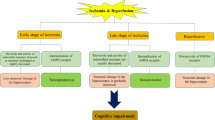Abstract
Free radicals are thought to be the most important cause of the reperfusion injury subsequent to ischemia. The antioxidant status of the tissue affected by ischemia-reperfusion is of great importance for the primary endogenous defense against the free radical induced injury. This investigation was performed to evaluate the antioxidant enzyme capacity of the brain tissue in the ischemia-reperfusion period using an experimental global moderate (penumbral) ischemia model on rat brains. Experiments were performed on 45 male Sprague Dawley rats. Ischemia was induced by bilateral vertebral arteries cauterization and temporary bilateral carotid arteries occlusion and sustained for 10 minutes. At the end of ischemia (0 min reperfusion) and various reperfusion periods (20 min, 60 min, 240 min), rats were decapitated and brains were frozen in liquid nitrogen. Changes in the intracellular antioxidant enzyme (superoxide dismutase, glutathione peroxidase and catalase) activities were assessed in the rat brain tissues, by spectrophotometric methods. In all moderate ischemia-reperfusion groups, superoxide dismutase activities were found to have decreased significantly compared to the sham operated controls (P<0.05). During ischemia superoxide dismutase activity was lowered to 31% ofthat of the control group. The decreases were more significant in reperfusion groups, particularly in 60 min reperfusion (40%). Relatively smaller but still significant diminution was observed in glutathione peroxidase activities (P<0.05). The ratio of diminution was striking in 20 min and 60 min reperfusion groups with 26% of the sham operated rats. Conversely, moderate ischemia-reperfusion caused significant increase in catalase activities (P<0.05). The increment was 63% of the preischemic level with 10 min of moderate ischemia. In conclusion, activities of the major antioxidant enzymes were changed significantly in moderate brain ischemia-reperfusion. These results suggest that the disturbance in oxidant-antioxidant balance might play a part in rendering the tissue more vulnerable to free radical induced injuries.
Similar content being viewed by others
References
Beauchamp C, Fridovich I (1971) Superoxide dismutase improved assay and an assay applicable to acrylamide gels. Anal Biochem 44: 276–287
Chan PH (1996) Role of oxidants in ischemic brain damage Stroke 27: 1124–11
Chan PH, Chu L, Fishman RA (1988) Reduction of activities of superoxide dismutase but not of glutathione peroxidase in rat brain regions following decapitation ischemia. Brain Res 439: 388–390
Dirnagl U, Lindauer U, Them A, Schreiber S, Pfister HW, Koedel U, Reszka R, Freyer D, Villringer A (1995) Global cerebral ischemia in the rat: online monitoring of oxygen free radical production using chemiluminescence in vivo. J Cereb Blood Flow Metab 15: 929–940
Farbiszewski R, Bielawski K, Bielawska A, Sobaniec W (1995) Spermine protects in vivo the antioxidant enzymes in transiently hypoperfused rat brain. Acta Neurobiol Exp 19: 253–258
Forsman M, Fleischer JE, Milde JH, Steen PA, Michenfielder JD (1988) Superoxide dismutase and catalase failed to improve neurologic outcome after complete cerebral ischemia in the dog. Acta Anaesthesiol Scand 32: 152–155
Garcia JH, Anderson ML (1989) Physiopathology of cerebral ischemia. Crit Rev Neurobiol 4: 303–324
Goth L (1991) A simple method for determination of serum catalase activity and revision of reference range. Clin Chim Acta 196: 143–152
Gruener N, Gross B, Gozlan O, Barak M (1994) Increase in superoxide dismutase after cerebrovascular accident. Life Sci 270: 711–713
Gutteridge JMC (1995) Lipid peroxidation and antioxidants as biomarkers of tissue damage. Clin Chem 41: 1819–1828
Güner G, İşlekel H, Oto Ö, Hazan E, Açıkel Ü (1996) Evaluation of some antioxidant enzymes in lung carcinoma tissue. Cancer Lett 103: 233–239
Hakim AM (1987) The cerebral ischemic penumbra. Can J Neurol Sci 14: 557–559
Halliwell B (1989) Oxidants and the central nervous system: some fundamental questions. Acta Neurol Scand 126: 23–33
Ho YS, Magnenat JL, Gargano M, Cao J (1998) The nature of antioxidant defense mechanisms: a lesson from transgenic studies. Environ Health Perspect 106[Suppl 5]: 1219–1228
Horakova L, Uraz V, Ondrejickova O, Lukovic L, Juranek I (1991) Effect of stobadine on brain lipid peroxidation induced by incomplete ischemia and subsequent reperfusion. Biomed Biochim Acta 50: 1019–1025
Horakova L, Ondrejickova O, Uraz V, Lukovic L, Juranek I (1992) Short cerebral ischemia and subsequent reperfusion and treatment with stobadine. Experienta 48: 872–874
Imaizumi S, Wool Worth V, Kinouchi H, Chen SF, Fishman RA, Chan PH (1990) Liposome-entrapped superoxide dismutase ameliorates infarct volume in focal cerebral ischaemia. Acta Neurochir Suppl 51: 236–238
İşlekel S, Coşkun E, Demirtaş E, Özdamar N (1994) The effect of rat cerebral four vessels occlusion on somatosensory evoked potentials. Nörolojik Bilimler Dergisi 11: 23–31
Krause GS, White BC, Aust SD, Nayini NR, Kumar K (1988) Brain cell death following ischemia and reperfusion: a proposed biochemical sequence. Crit Care Med 16: 714–726
Liu XH, Kato H, Araki T, Itoyama Y, Kato K, Kogure K (1994) An immunohistochemical study of copper/zinc superoxide dismutase and manganese superoxide dismutase following focal cerebral ischemia in the rat. Brain Res 25: 257–266
Lowry OH, Rosebrough NJ, Farr AL, Randall RJ (1951) Protein measurement with the folin phenol reagent. J Biol Chem 193: 265–275
McCord JM (1993) Human disease, free radicals, and the oxidant/antioxidant balance. Clin Biochem 26: 351–357
Medina L, Figueredo-Cardenas G, Reiner A (1996) Differential abundance of superoxide dismutase in interneurons versus projection neurons and in matrix versus striosome neurons in monkey striatum. Brain Res 708: 59–70
Michowiz SD, Melamed E, Pikarsky E, Rappaport ZH (1990) Effect of ischemia induced by middle cerebral artery occlusion on superoxide dismutase activity in rat brain. Stroke 21: 1613–1617
Mishra OP, Papadopoulos MD, Wagerle LC (1990) Anti-oxidant enzymes in the brain of newborn piglets during ischemia followed by reperfusion. Neuroscience 35: 211–215
Mrsuljia BB, Stanimirovic D, Micic DV, Spatz M (1990) Excitatory amino acid receptors, oxido-reductive process and brain edema following transient ischemia in gerbils. Acta Neurochir Suppl 51: 180–182
Mullan JC, Korosue K, Heros RC (1993) The use of somatosensory evoked potential monitoring to produce a canine model of uniform moderately severe stroke with permanent arterial occlusion. Neurosurgery 32: 967–973
Ohtsuki T, Matsumato M, Suzuki K, Taniguchi N, Kamado T (1993) Effect of transient forebrain ischemia on superoxide dismutases in gerbil hipocampus. Brain Res 620: 305–309
Paglia DE, Valentine WN (1967) Studies on the quantitative and qualitative characterization of erythrocyte glutathione peroxidase. J Lab Clin Med 1: 158–169
Pulsinelli WA, Buchan AM (1988) The four vessel occlusion rat model: method for complete occlusion of vertebral arteries and control of collateral circulation. Stroke 19: 913–914
Pulsinelli WA, Brierley JB, Plum F (1982) Temporal profile of neuronal damage in a model of transient forebrain ischemia. Ann Neurol 11: 491–498
Reilly PM, Schiller HJ, Bulkey GB (1991) Pharmacological approach to tissue injury mediated by free radicals and other reactive oxygen metabolites. Am J Surg 161: 488–502
Rice-Evans CA, Burdon RH (eds) (1994) Antioxidants and free radical scavengers. In: Free radical damage and its control. Elsevier Science, UK pp 113–129
Spitz DR, Oberley LW (1989) An assay for superoxide dismutase activity in mammalian tissue homogenates. Anal Biochem 179: 8–18
Stanimirovic DB, Micic DV, Markovic M, Spatz M, Mrsulja BB (1994) Therapeutic window for multiple drug treatment of experimental cerebral ischemia in gerbils. NeurochemRes 19: 189–194
Sun Y, Oberley LW, Li Y (1988) A simple method for clinical assay of superoxide dismutase. Clin Chem 34: 497–500
Tokuda Y, Uozumi T, Kawasaki T (1993) The superoxide dismutase activities of cerebral tissues, assayed by the chemiluminescence method, in the gerbil focal ischemia/reperfusion and global ischemia models. Neurochem Int 23: 107–114
Toyoda T, Lee KS (1997) Differential induction of superoxide dismutase in core and penumbra regions after transient focal ischemia in the rat neocortex. Neurosci Lett 10: 235: 29–32
Ueda Y, Obrenovitch TP, Lok SY, Sarna GS, Symaon L (1992) Efflux of glutamate produced by short ischemia of varied severity in rat striatum. Stroke 23: 1–8
Weisbrot-Lefkowitz M, Reuhl K, Perry B, Chan PH, Inouye M Mirochnitchenko O (1998) Overexpression of human glutathione peroxidase protects transgenic mice against focal cerebral ischemia/reperfusion damage. Brain Res Mol Brain Res 53: 333–338
White BC, Grossman LI, Krause GS (1993) Brain injury by global ischemia and reperfusion: a theoretical perspective on membrane damage and repair. Neurology 43: 1656–1665
Author information
Authors and Affiliations
Corresponding author
Rights and permissions
About this article
Cite this article
İşlekel, S., İşlekel, H., Güner, G. et al. Alterations in superoxide dismutase, glutathione peroxidase and catalase activities in experimental cerebral ischemia-reperfusion. Res. Exp. Med. 199, 167–176 (1999). https://doi.org/10.1007/s004330050121
Received:
Accepted:
Published:
Issue Date:
DOI: https://doi.org/10.1007/s004330050121



